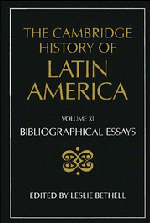Book contents
- Frontmatter
- I THE INDIGENOUS PEOPLES OF MIDDLE AND SOUTH AMERICA ON THE EVE OF THE CONQUEST
- II COLONIAL SPANISH AMERICA
- III COLONIAL BRAZIL
- IV THE INDEPENDENCE OF LATIN AMERICA
- V LATIN AMERICA: ECONOMY, SOCIETY, POLITICS, c. 1820 TO c. 1870
- VI LATIN AMERICA: ECONOMY, SOCIETY, POLITICS, c. 1870 to 1930
- VII LATIN AMERICA: ECONOMY, SOCIETY, POLITICS, 1930 to c. 1990
- 1 Population
- 2 The Latin American economies, 1929–1939
- 3 The Latin American economies, 1939–c. 1950
- 4 The Latin American economies, 1950–1990
- 5 Urban growth and urban social structure
- 6 Agrarian structures
- 7 State organization
- 8 Democracy
- 9 The Left
- 10 The military in politics
- 11 The urban working class and labour movements
- 12 Rural mobilizations
- 13 Women in twentieth-century Latin America
- 14 The Catholic church
- 15 The Protestant churches
- 16 Mexico, c. 1930–1946
- 17 Mexico since 1946
- 18 Central America
- 19 Guatemala
- 20 El Salvador
- 21 Honduras
- 22 Nicaragua
- 23 Costa Rica
- 24 Panama
- 25 The Panama Canal Zone, 1904–1979
- 26 Cuba, c. 1930–1959
- 27 Cuba since 1959
- 28 The Dominican Republic
- 29 Haiti
- 30 Puerto Rico
- 31 Argentina, 1930–1946
- 32 Argentina since 1946
- 33 Uruguay
- 34 Paraguay
- 35 Chile, c. 1930–c. 1960
- 36 Chile since c. 1960
- 37 Peru, 1930–c. 1960
- 38 Peru since c. 1960
- 39 Bolivia
- 40 Colombia
- 41 Ecuador
- 42 Venezuela
- 43 Brazil
- VIII IDEAS IN LATIN AMERICA SINCE INDEPENDENCE
- IX LATIN AMERICAN CULTURE SINCE INDEPENDENCE
- X THE INTERNATIONAL RELATIONS OF LATIN AMERICA SINCE INDEPENDENCE
- THE CAMBRIDGE HISTORY OF LATIN AMERICA
38 - Peru since c. 1960
from VII - LATIN AMERICA: ECONOMY, SOCIETY, POLITICS, 1930 to c. 1990
Published online by Cambridge University Press: 28 March 2008
- Frontmatter
- I THE INDIGENOUS PEOPLES OF MIDDLE AND SOUTH AMERICA ON THE EVE OF THE CONQUEST
- II COLONIAL SPANISH AMERICA
- III COLONIAL BRAZIL
- IV THE INDEPENDENCE OF LATIN AMERICA
- V LATIN AMERICA: ECONOMY, SOCIETY, POLITICS, c. 1820 TO c. 1870
- VI LATIN AMERICA: ECONOMY, SOCIETY, POLITICS, c. 1870 to 1930
- VII LATIN AMERICA: ECONOMY, SOCIETY, POLITICS, 1930 to c. 1990
- 1 Population
- 2 The Latin American economies, 1929–1939
- 3 The Latin American economies, 1939–c. 1950
- 4 The Latin American economies, 1950–1990
- 5 Urban growth and urban social structure
- 6 Agrarian structures
- 7 State organization
- 8 Democracy
- 9 The Left
- 10 The military in politics
- 11 The urban working class and labour movements
- 12 Rural mobilizations
- 13 Women in twentieth-century Latin America
- 14 The Catholic church
- 15 The Protestant churches
- 16 Mexico, c. 1930–1946
- 17 Mexico since 1946
- 18 Central America
- 19 Guatemala
- 20 El Salvador
- 21 Honduras
- 22 Nicaragua
- 23 Costa Rica
- 24 Panama
- 25 The Panama Canal Zone, 1904–1979
- 26 Cuba, c. 1930–1959
- 27 Cuba since 1959
- 28 The Dominican Republic
- 29 Haiti
- 30 Puerto Rico
- 31 Argentina, 1930–1946
- 32 Argentina since 1946
- 33 Uruguay
- 34 Paraguay
- 35 Chile, c. 1930–c. 1960
- 36 Chile since c. 1960
- 37 Peru, 1930–c. 1960
- 38 Peru since c. 1960
- 39 Bolivia
- 40 Colombia
- 41 Ecuador
- 42 Venezuela
- 43 Brazil
- VIII IDEAS IN LATIN AMERICA SINCE INDEPENDENCE
- IX LATIN AMERICAN CULTURE SINCE INDEPENDENCE
- X THE INTERNATIONAL RELATIONS OF LATIN AMERICA SINCE INDEPENDENCE
- THE CAMBRIDGE HISTORY OF LATIN AMERICA
Summary
Peruvian economic trends since 1960 are analysed in R. Thorp and G. Bertram, Peru, 1890–1977: Growth and Policy in an Open Economy (London, 1978) E. V. K. Fitzgerald, The Political Economy of Peru, 1965–1978: Economic Development and the Restructuring of Capital (Cambridge, Eng., 1979); and Oscar Dancourt, Sobre las políticas macro-económicas en el Perú, 1970–1984 (Lima, 1986). A critical bibliographical review of economic writings can be found in Teobaldo Pinzas, La economía peruana, 1950–1978: Un ensayo bibliográfico (Lima, 1981).
The economic problems of Belaúnde’s first government (1963–8) are analysed in P. P. Kuczynski, Peruvian Democracy under Economic Stress: An Account of the Belaúnde Administration, 1963–1968 (Princeton, N. J., 1977). On the distribution of income, see R. Webb, Government Policy and the Distribution of Income in Peru, 1963–1973 (Cambridge, Mass., 1977), and Shane Hunt, ‘Distribution, growth and government: Economic behavior in Peru’, in Gustave Rainis (ed.), Government and Economic Development (New Haven, Conn., 1971), 375–416. The problems of industrialization have been treated by M. Beaulne, Industrialización por sustición de importaciones, 1958–1969 (Lima, 1975); M. Vega Centeno, Crecimiento, industrialización y cambio técnico en el Perú, 1955–1980 (Lima, 1983); and J. Torres, Estructura económica de la industria en el Perú (Lima, 1975). There is an abundant bibliography on agrarian problems. See J. Matos and J. M. Mejía, La reforma agraria en el Perú (Lima, 1980); E. Alvarez, Política económica y agricultura en el Perú, 1969–1979 (Lima, 1983); J. M. Caballero, Economía agraria de la sierra peruana: Antes de la reforma agraria de 1969 (Lima, 1981); A. Figueroa, Capitalist Development and the Peasant Economy in Peru (Cambridge, Eng., 1984); Raúl Hopkins, Desarrollo desigual y crisis de la agricultura peruana, 1944–1969 (Lima, 1981); and E. González, Economía de la comunidad campesina (Lima, 1984).
- Type
- Chapter
- Information
- The Cambridge History of Latin America , pp. 799 - 806Publisher: Cambridge University PressPrint publication year: 1995

